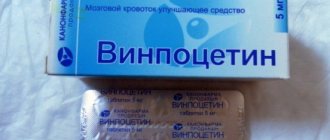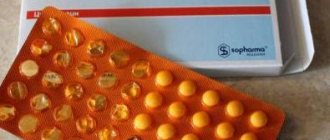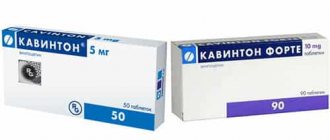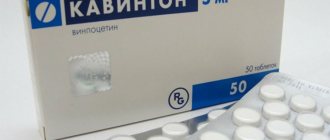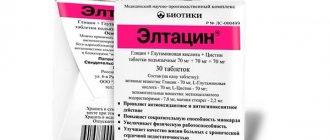Vinpocetine forte is a medication that has a vasodilator, antihypoxic and cerebroprotective effect. Helps improve blood circulation in the brain, increase the stability of brain cell tissue, oxygen deficiency and ischemia. Let's read the instructions for the drug.
Release form and components
Vinpocetine Forte is produced in the form of flat round tablets, white or white with a yellow tint. There is a risk on one side and a chamfer on the other. Tablets are packaged in jars of 10, 20, 30, 40, 50 and 100 pieces, or in shaped packages with cells of 10, 20, 30 or 50 pieces, which in turn are packed in a cardboard box.
The active component of the drug is vinpocetine. The following additional components were used in the production of the medicine:
- sodium carboxymethyl starch;
- lactose monohydrate (milk sugar);
- microcrystalline cellulose;
- magnesium stearate;
- povidone.
Ingredients may vary, this is directly related to the manufacturer.
Instructions for use
If required, the daily dose of the drug can be increased to 20-30 mg. The duration of the course of treatment should be determined by the doctor, based on the patient’s condition and the type of disease from which he suffers.
The instructions for use of the drug say that it can only be used by persons who have already reached the age of 18. That is, Vinpocetine is prohibited for children.
Despite this, this medication is still prescribed to pediatric patients for the treatment of various ailments, where it shows good results. Vinpocetine is also included in the treatment regimen for newborns and infants suffering from perinatal encephalopathy.
If we talk about older children, the drug is prescribed to them for recovery after a head injury and for mental retardation
The dosage of the drug directly in childhood is established individually, where the ailment that must be treated with effective Vinpocetine is taken into account.
Upon completion of treatment with Vinpocetine, regardless of the reason for its use, the drug should be discontinued gradually. To do this, the dosage must be reduced. Abruptly stopping the medication is not recommended.
Instructions for use of Vinpocetine are included with the drug. It is recommended to consult a doctor before use.
Adults are prescribed 1 tablet of 5 or 10 mg three times a day.
The recommended dosage of injections is 20 ml once a day. If the body accepts the drug well, the dosage is increased. The maximum value is 1 mg/kg. This dosage is used for 3-4 days. The full therapeutic course is two weeks.
The drug form Akri is recommended to take one tablet three times a day. The minimum permissible dosage is 15 mg. For advanced pathologies or acute diseases, the doctor may increase the dosage. The upper limit is 30 mg.
The maximum dosage of the drug is taken for several days. After the patient’s condition improves, it is reduced to a minimum value. The duration of therapy is determined by the doctor, based on the nature of the disease and the individual characteristics of the patient. Typically the duration of treatment is 3 months. It is not recommended to increase the period.
Can Cavinton, in interaction with other drugs, not cure, but, on the contrary, worsen hearing?
Orally 5 mg (1 tablet) after meals. The drug is used 3 times a day. The initial daily dose is 15 mg. The maximum daily dose is 30 mg. The duration of treatment is up to 3 months.
Even the white light was not nice to him then. This problem appeared recently. We bought it right away, the price is very conservative and affordable. You need to drink them three times a day after meals. You need to take the medicine in courses. My husband had no allergies or other side effects. The medicine has contraindications. And so it happened. Alexander, the course should be prescribed by a doctor, since there are many causes of headaches and it is impossible for a non-specialist to understand what causes a headache without a minimum of research.
Benefits and mechanism of operation
Vasodilator drugs for cervical osteochondrosis contribute to:
- improving cerebral blood flow,
- restoration of damaged nerve tissue,
- normalization of the tone of the walls of blood vessels,
- reducing swelling,
- restoration of blood viscosity,
- brain cell regeneration,
- improving the supply of oxygen and nutrients to the cells of the head,
- suppressing muscle spasms.
According to the mechanism of influence, agents for dilating blood vessels are divided into 2 groups - effects on the center and on the periphery. Group 1 drugs directly affect the central circulatory system and the brain. Peripheral medications relieve spasms, increase the tone of vascular walls, improve blood circulation by affecting the parasympathetic nerve pathways and smooth muscle cells of the body.
List of vasodilator drugs for osteochondrosis
Vasodilator drugs for the brain for osteochondrosis have different principles of action. The doctor selects the most suitable medicine for the patient, depending on the symptoms of the disease and pathologies of the body. The list of drugs for dilating blood vessels for osteochondrosis includes effective drugs that help improve well-being.
"Pentoxifylline"
It is prescribed to thin the blood, improve metabolism in brain cells, and normalize the elasticity of the walls of blood vessels. Not recommended for use during pregnancy or lactation. Do not use if the patient has poor blood clotting. "Pentoxifylline" for osteochondrosis is taken in the form of tablets or intramuscular injections. It is sold in pharmacies strictly according to prescription, as it has serious side effects in case of overdose. During treatment, allergic reactions, skin rashes, nausea and loss of coordination may occur.
Cavinton tablets and injections
Used to dilate blood vessels in the brain, increase blood circulation, and supply brain cells with oxygen. The medicine prevents platelets from sticking together. Used in cases of circulatory disorders in the brain, weakening of the elasticity of the walls of blood vessels in osteochondrosis. During administration, a slight decrease in blood pressure is observed. Available in the form of tablets and solution for injection. It is forbidden to take by pregnant women.
"Cinnarizine"
The action of the drug is aimed at blocking calcium channels in the vertebral artery. “Cinnarizine” for cervical osteochondrosis is prescribed to restore the metabolism of damaged tissues, reduce vascular spasm, and improve blood microcirculation. It slows down the reaction rate. It is not recommended for use by people driving vehicles or working with dangerous machinery. Adverse reactions include drowsiness, dry mouth, and gastrointestinal upset. Take Cinnarizine for osteochondrosis of the cervical spine before or after meals, without chewing. The degree of the disease affects the dosage.
"Piracetam"
Neuroprotective drugs normalize the functioning of nerve tissues, improve memory and increase mental performance. “Piracetam” has a positive effect on the metabolic processes of the brain and also improves blood flow. If you violate the rules for taking Piracetam, the following adverse reactions occur:
- impaired concentration,
- imbalance,
- irritability,
- nausea,
- vomit,
- convulsions.
"Vinpocetine"
Therapy with the drug reduces platelet aggregation, improves metabolic processes and oxygen delivery to brain cells. Prescribed for the treatment of osteochondrosis. Vinpocetine does not affect blood pressure. Contraindicated for pregnant women, nursing mothers and children. Adverse reactions include dizziness, increased heart rate, flushing of the face and a feeling of heat.
"Trental"
Protects blood vessels from harmful effects. Improves blood microcirculation in tissues, restores the elasticity of red blood cells. It is prescribed to patients with lumbar osteochondrosis, circulatory disorders in the vessels of the spinal column. Available in the form of tablets and solution. Possible adverse reactions:
- dizziness,
- change in heart rate,
- stool disorder,
- stomach pain.
"Actovegin"
An effective drug whose action is aimed at activating metabolism in cells and increasing the elasticity of the walls of blood vessels. Doses and method of administration depend on the complexity of the disease. A common side effect is an allergy to the components of the medicine. Contraindicated during pregnancy and lactation.
"Mexidol"
An antioxidant that is intended to restore metabolic mechanisms in tissues, dilate blood vessels in osteochondrosis, improve the condition of platelets and red blood cells. Administered intravenously or intramuscularly. Mexidol is contraindicated in cases of kidney and liver dysfunction. Adverse reactions are rare, including dry mouth and nausea.
"Eufillin"
The action of the drug is aimed at reducing platelet aggregation, improving blood circulation, and relieving vascular spasms. Used during physiotherapy. "Eufillin" reduces the reaction rate. Prohibited for patients driving vehicles. Contraindications include liver and kidney failure, stomach ulcers, internal bleeding.
httpv://www.youtube.com/watch?v=embed/AwFlFojV_Ko
Indications for use
Vinpocetine is recommended in the following cases:
- Atherosclerosis of the arteries, narrowing of the lumen.
- Acute or chronic cerebrovascular accidents.
- Diffuse or multifocal damage to the vessels of the head.
- Neurological disorders after intracranial injury.
- Vegetative-vascular dystonia against the background of menopausal changes.
- Blood defects of the retina of the eye.
- Meniere's disease is a disorder in the inner ear without inflammation, when attacks of dizziness, sensations of noise, and hearing loss are repeated.
The drug is effective against memory impairment, increased stress, and helps cope with the consequences of stroke and acute cerebral infarction. Reduces vasospasm, returns normal blood supply to ischemic areas of the brain.
Vinpocetine analogs
Analogues are drugs with the same active ingredient or similar therapeutic effect, which are produced by different pharmaceutical companies. Each manufacturer gives the drug its own name. Analogues of the drug "Vinpocetine" in terms of the substance included in the composition are the drugs that will be given below.
The most popular:
- Vinpocetine Forte.
- "Vinpocetine Acree"
- "Vinpocetine-Darnitsa".
- "Cavinton".
- "Bravinton".
What to prefer - Vinpocetine or Vinpocetine Forte?
The main difference between Vinpocetine Forte tablets lies mainly in the fact that one pill contains double the amount of the main substance - 10 mg.
Medicines similar to Vinpocentin in their effects on the body are the following medicines:
- "Korsavin";
- "Cavinton";
- "Winpoton."
- "Bravinton".
- "Piracetam";
- "Neurovin";
- "Oxopotin";
- "Vicebrol";
- "Actovegin".
"Carnicetine" is an analogue of "Vinpocetine" in tablets. These gelatin hard capsules are available in different packaging. In cardboard packaging and in a polymer jar. The product acts as an antioxidant and has metabolic effects.
A cheap analogue of Vinpocetine is Cerebrolysate, costs 200-220 rubles. Solution in ampoules for injection. Contains amino acids that penetrate directly to nerve tissues. The use of this analogue of Vinpocetine in ampoules is advisable for brain injuries, strokes, cerebral palsy and neuropathies.
The best analogues of Vinpocetine
The original medicinal product received its name due to its main active ingredient – vinpocetine. This is a corrector of cerebral blood flow disorders, synthesized from the alkaloid Vinca minor.
When selecting Vinpocetine analogues, doctors first consider drugs based on the same active ingredient. Due to the presence of auxiliary components, their properties and characteristics can vary significantly, so therapy must be carried out under medical supervision.
"Cavinton"
The basis of the drug is vinpocetine, which determines the principle of action and effects of the product. A course of medication leads to improved blood circulation in the brain by dilating blood vessels and preventing the formation of blood clots. Additionally, the neuroprotective properties of the drug and its ability to eliminate areas of hypoxia are traced.
Areas of application of the analogue:
- neurology - a disorder of blood circulation in the brain in acute or chronic form. Neurological or mental pathologies due to decreased functionality of blood vessels inside the skull. Vegetative symptoms of menopause, PMS;
- ophthalmology – vision problems caused by vasospasm and their degenerative disorders. Some forms of glaucoma;
- otolaryngology – hearing loss due to vascular problems, malfunctions of the vestibular apparatus.
The advantages of the drug include its ability to quickly and well cope with blood circulation disorders in the medulla and central nervous system problems.
Signs of positive dynamics appear after a week of therapy. Vinpocetine in the product quickly accumulates in the body to its maximum level. It is also characterized by a high degree of bioavailability and is available in a wide range of dosage forms. The medicine does not always give the desired effect against the background of hyperexcitability. Sometimes a lasting positive response becomes apparent only after the end of therapy. Unlike other vinpocetine-based products, Cavinton often causes side effects. It is also an order of magnitude more expensive than its original counterpart.
"Winpoton"
Another drug that can replace Vinpocetine due to the presence of the same component in the base. Its action is to relax the muscle layer of the cerebral blood vessels. This leads to an improvement in blood flow, and the brain substance begins to more actively receive oxygen. A course of taking the composition potentiates the processing of carbohydrates, the tissues of the nervous system begin to better resist hypoxia. The healing properties of Vinpoton are enhanced by a decrease in blood viscosity, which is one of the actions of the drug. The drug, like its analogues, is used in neurology, ophthalmology, and for ENT pathologies.
The medication has several weaknesses, due to which it is inferior to other synonyms of Vinpocetine. The therapeutic effect appears only after 1-2 weeks of therapy. In terms of price, Vinpoton is one of the most expensive among its analogues. It is presented in a single form of release - tablets, which in some cases complicates treatment. The advantages include the high bioavailability of the composition and the convenience of a bottle of tablets.
"Korsavin"
One of the most popular analogues of Vinpocetine based on the same active ingredient. Its use gives all the required effects: stimulation of metabolism, potentiation of the processes of nutrition and respiration of tissues, establishment of processes for delivering necessary substances to them. The medicine is often administered as a symptomatic remedy as part of complex therapy for transient attacks, stroke of any type. The medication is effective for atherosclerosis of cerebral vessels, hypertensive and post-traumatic encephalopathy, dementia due to damage to the blood channels.
The main advantage of the product is its price; according to this indicator, Korsavin is inferior to all other analogues. The active substance quickly reaches its maximum level in the blood, which becomes the key to a lasting therapeutic effect. Adverse reactions during such treatment rarely occur, but in case of pathologies of the heart and blood vessels, the drug is taken with increased caution. The disadvantages are the presence of only one dosage form and the low bioavailability of the drug.
"Bravinton"
Another product based on vinpocetine with all the same properties. Due to the minimum
the number of contraindications and the low likelihood of side effects, it is sometimes prescribed in the absence of a specific diagnosis. The medication increases mental productivity, relieves memory impairment, eliminates sleep problems and dizziness. It is often prescribed to people with pathological weakness and lethargy, headaches of various origins. According to doctors, this is one of the safest drugs among all analogues of Vinpocetine.
An additional advantage of the product is the presence of several dosage forms, which simplifies therapy in difficult situations. At the same time, its cost remains one of the lowest among analogues. Doctors call the negative point the fact that Bravinton is not easy to find in pharmacies. Often, due to supply problems, patients have to switch from this drug to less convenient synonyms.
Indications for use
The main indications for prescribing the drug are:
- Conditions after strokes.
- Circulatory disorders in the brain in chronic forms.
- Dementia, which can be caused by circulatory problems in the brain.
- Transient ischemic attacks.
- Post-traumatic and hypertensive encephalopathy.
- Atherosclerosis.
- Vertebrobasilar and cerebrovascular insufficiency.
Ophthalmologists, as a rule, prescribe this drug for various chronic vascular diseases, which include vasospasms and thrombosis of the vein or central arteries of the retina, as well as retinopathy of diabetic etiology.
In otology, this pharmacological drug is used for Meniere's disease, idiopathic tinnitus, and decreased hearing acuity.
Indications for use: what is it prescribed for?
Indicated for use in the following diseases and conditions:
- for cerebrovascular disorders (stroke, vertebrobasilar insufficiency, head injuries, atherosclerotic damage to the vascular system in the brain, decreased intellectual abilities due to vascular insufficiency, encephalopathy resulting from hypertension or injury, and other diseases);
- with intermittent insufficiency and vasospasm;
- with partial blockage of arterial vessels;
- for headaches and dizziness;
- with memory impairment;
- for motor activity disorders;
- with changes in the eye (both in the retina and in the vessels);
- with thrombosis of arterial and venous vessels of the eyes;
- for degenerative diseases of the macula;
- for glaucoma resulting from blockage of blood vessels;
- for all kinds of disorders of the auditory function and vestibular system in elderly patients, as well as those arising against the background of vascular insufficiency or the influence of toxic substances;
- with Meniere's disease, cochleovestibular neuritis;
- with hearing loss, noise effect in the ears;
- with vascular-vegetative symptoms that appeared during menopause.
What is better Vinpocetine or Cavinton
These drugs are medications that improve blood flow in the brain. They are based on the same active ingredient - vinpocetine, which has a complex effect and can improve the activity of the circulatory system of the brain. This element has a positive effect on the metabolism in it and affects the rheological qualities of the blood (reduces the level of coagulation).
It follows that Vinpocetine and its analogue have the following qualities:
- vasodilator;
- neuroprotective;
- antiaggregation;
- antihypoxic;
- improving cerebral circulation.
Such pharmacological agents have the same list of indications, side effects and contraindications. The main difference between these products is that they are produced by different manufacturers and have different prices. So what to choose - Cavinton or Vinpocetine?
Which medicine to choose in each specific case can only be decided by a specialist and the consumer, since both of these medicines have the same effect on the body.
The drug we are describing is produced in Russia, as a result of which it is somewhat cheaper than the imported analogue of Vinpocetine, Cavinton.
In medical practice, the drug Cavinton is most often used, since it is a more modern pharmacological drug that causes fewer adverse reactions and is more well tolerated.
Let's consider other analogues.
Analogs
If for some reason the medicine cannot be taken, the doctor may prescribe analogues with the same active ingredient:
- Vinpocetine;
- Cavinton;
- Korsavina;
- Bravinton;
- Vincetina.
Sometimes, in order to improve blood circulation in the brain, the doctor may prescribe an analogue of the drug, which contains other substances that have a similar effect:
- Glycine;
- Lucetam;
- Nootropil;
- Pantogam;
- Piracetam;
- Fezama, etc.
You should not replace the medicine with an analogue yourself. First, you need to consult with your doctor, since each medicine has contraindications for use that need to be excluded.
Vinpocetine or Cavinton: which is better?
Since these drugs are analogues in the active component, they have the same effect on the body. Many doctors prefer Cavinton, since they use purified and high-quality ingredients to make it. The effect of these drugs is the same. Therefore, a specialist will decide which medication is best in each specific case.
Table comparing drug analogues by cost. Data was last updated on 09/04/2020 00:05.
| Vinpocetine | Found in 2 pharmacies | from: 73.00 rub. up to: 129.00 rub. | |||
| 73.00 | BUY | ||||
| Pharmacy Dialogue | Vinpocetine-OBL (5 mg tablet No. 50) | 129.00 | BUY | ||
| Glycine | Found in 3 pharmacies | from: 50.00 rub. up to: 4960.00 rub. | |||
| 50.00 | BUY | ||||
| Pharmacy Dialogue | Glycine forte tablets No. 20 | 82.00 | BUY | ||
| Pharmacy Medic | Magnesium Glycinate Plus (as magnesium bisglycinate) caps. No. 120 | 4960.00 | BUY | ||
| Lutsetam | Found in 2 pharmacies | from: 66.00 rub. up to: 114.00 rub. | |||||||
| |||||||||
| Name | Price | Details | ||
| Nootropil | from 218.00 rub. | hide see prices in detail | ||
| 218.00 | BUY | |||
| Pharmacy Dialogue | Nootropil (tab.p/vol.800mg No. 30) | 264.00 | BUY | |
| 494.00 | BUY | ||
| ZdravCity | Pantogam tablets 500 mg 50 pcs. | 702.00 | BUY |
| 79.00 | BUY | ||
| Pharmacy Dialogue | Piracetam capsules 400 mg No. 60 | 134.00 | BUY |
| 295.00 | BUY |
Contraindications
Vinpocetine and its Forte form are recommended to be taken in the following cases:
- Lack of cerebral circulation in acute or chronic form;
- Encephalopathy that arose after an injury;
- Discirculatory encephalopathy, which causes dizziness, pain in the head, and memory problems;
- Pathologies of the hearing organs;
- Vegetative-vascular dystonia, developing against the background of menopause;
- Pathologies of the choroid and vascular diseases of the retina.
The use of the Acri form is relevant in the following cases:
- Hearing diseases;
- Pathologies of the organs of vision;
- Prevention and treatment of brain diseases.
The product has the following contraindications:
- Allergic reactions to the product;
- Individual intolerance to any component of the composition;
- Severe arrhythmia;
- The period of bearing a baby;
- Minor children;
- Acute hemorrhagic stroke;
- Ischemic heart pathology.
Side effects and contraindications
During treatment with Vinpocetine forte, negative reactions occur in rare cases. There is a possibility of developing side effects in relation to the nervous, vascular system, gastrointestinal tract, disorders of the heart and allergic symptoms:
- neurological symptoms manifest themselves in the form of dizziness, headaches, insomnia and other disorders in the functionality of the nervous system;
- the cardiovascular and hematopoietic system may respond to taking the drug by slowing down cardiac conduction functions, changes in segments and intervals of heart function, decreased blood pressure, a feeling of increased heart rate, extrasystole, hot flashes;
- the gastrointestinal tract may react to the tablets with dry mouth, nausea, and heartburn.
Increased sweating and allergic symptoms may also occur.
When prescribing Vinpocetine forte, all possible contraindications must be excluded. It is prohibited to take these tablets if you have:
- hypersensitivity to any components in the composition;
- severe chronic coronary heart disease;
- arrhythmias occurring in severe form;
- acute phase against the background of a hemorrhagic stroke in the brain;
- increased intracranial pressure.
In addition, the drug is contraindicated for women during pregnancy, as well as during the lactation period.
Methods of administration and dosage of the drug
In the form of injections, the drug "Vinpocetine" is administered intravenously using a dropper. The speed of this process should not exceed 90 drops per minute. The concentrated drug is prohibited for injection, subcutaneously and intramuscularly.
The initial dosage is 20 mg of the active substance per day, that is, two ampoules, which are diluted in half or one liter of solution, which is intended for intravenous infusion. Subsequently, the average dosage is 50 mg per day. The duration of treatment with Vinpocetine in the form of injections is no more than 14 days.
After completion of therapy, the use of this drug in tablet form may be prescribed. Initially, 5 or 10 mg of the active substance is prescribed, that is, one or two tablets, three times a day. This medicine is used during or immediately after meals. Maintenance treatment consists of taking one tablet of the medication three times a day for about two months.
Vinpocetine: indications for use
The drug is prescribed for brain pathologies, neurological and mental manifestations caused by circulatory disorders.
The use of the drug is justified for:
- ischemic stroke;
- encephalopathy;
- vascular damage to the retina and membranes of the eyes;
- cerebral atherosclerosis;
- VSD;
- thrombosis of eye vessels;
- vascular dementia;
- secondary type glaucoma;
- circulatory disorders in TBI;
- arterial hypertension;
- migraines, dizziness;
- decreased intellectual abilities;
- hemorrhagic stroke in the rehabilitation period.
It is assumed that Meniere's disease occurs due to impaired blood flow and innervation in the inner ear, insufficient nutrition of the cells of the vestibule of the ear, and VSD. Reviews indicate that Vinpocetine eliminates or reduces the intensity of dizziness, noise, and nausea.
The drug is recommended to reduce the severity of symptoms of stroke, ischemic attacks, psycho-emotional disorders, asthenia during menopausal syndrome.
Vinpocetinum can be used for the prevention and treatment of diabetic angiopathy of the retina and lower extremities.
Vinpocetine price
The price of Vinpocetine is quite low and lower than that of analogues of this drug. The average price for 50 Vinpocetine tablets (one pack) is 109 rubles. The price for Vinpocetine in ampoules (10 pieces) is 66 rubles.
The cost of Vinpocetine tablets and concentrate varies depending on the number of tablets and the network of pharmacies where the drug is purchased.
The popularity of Vinpocetine is due not only to its excellent effectiveness in treating diseases, but also to its very affordable price. Moreover, this drug is one of the cheapest when compared directly with analogues. At the same time, you can buy Vinpocetine in the form the patient needs at any pharmacy in the city.
Dispensing conditions at the pharmacy and price
Vinpocetine forte is sold in pharmacies upon presentation of a prescription. A package of 30 tablets costs approximately 80-91 rubles.
Table of current prices for the drug Vinpocetine
in online pharmacies. Data was last updated on 09/04/2020 00:05.
| Pharmacy | Name | Price | |
| Pharmacy Dialogue | Vinpocetine-OBL (5 mg tablet No. 50) | 129.00 | BUY |
| ZdravCity | Vinpocetine conc. for prig solution for inf. 0.5% 2ml 10 pcs. | 73.00 | BUY |
Release form and composition
Vinpocetine has two forms of release:
- Pills. The shape is round, convex on both sides, and on one side there is a serif. Shade – pale yellow or white. The product is available in cellular packages of 10 pcs. The pack is made of cardboard. Contains from 1 to 10 cellular packaging per pack
- High concentration solution for droppers. The drug has an absolute degree of transparency. May be slightly colored. Available in ampoules made of dark glass. The content of the drug is 2 or 5 ml per ampoule. The blister contains 5-10 ampoules. The pack is made of cardboard. Contains 1 or 2 blisters per package.
The main active ingredient that determines the properties of the product is vinpocetine.
A Vinpocetine tablet contains from 5 to 10 mg of the main component. Its effect is enhanced by colloidal silicon dioxide, potato starch, magnesium stearate, lactose.
Pharmacodynamics and pharmacokinetics
International nonproprietary name – Vinpocetine. Improves microcirculation in the brain and metabolism. Inhibits the activity of enzymes that hydrolyze the phosphodiester bond, which leads to the accumulation of cyclic adenosine monophosphate in tissues.
Promotes the expansion of the lumen of blood vessels due to the vasodilator effect. The result is a slight decrease in blood pressure.
The drug increases the level of catecholamines that are present in brain cells.
After taking Vinpocetine, the drug is instantly absorbed by the intestinal walls and enters the blood. The maximum blood level of the drug is observed 60 minutes after use. Half-life is eliminated after 5 hours.
